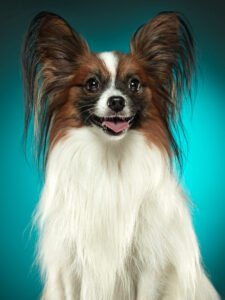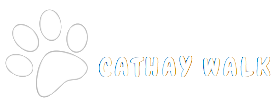There are a lot of dogs out there who have better hair than most models on the runway, with their flowing locks, wild curls, and stunning colors. These long-haired dog breeds usually require more care and consistency than their short-haired counterparts, but watching their silky coats streaming in the wind as they gallop toward you across the dog park is worth the work. If you’re considering adopting a dog, here are some of the most popular and adorable breeds with catwalk-ready coats.
What’s considered a long-haired dog?
There’s variation in what hair length qualifies a dog as “long-haired,” considering that a tiny dog’s long hair would scarcely cover the body of a bigger dog. But typically, long-haired breeds have hair that is several inches or more in length.

Small long-haired dog breeds
1. Papillon
The Papillon’s name comes from the French word for butterfly, referencing the luxurious large ears that fan out from the tops of their tiny heads under flowing, luxurious locks. The Papillon is a small toy breed, and while usually considered a lap-dog, they can also be highly energetic and active. Papillons are super smart dogs who are quick to learn and eager to please. They love people and other pets and kids, but be sure small children are introduced to them carefully as they are very delicate dogs.
2. Lhasa Apso
A well-groomed Lhasa Apso has a silky coat that parts down their head and hangs down their ears. You can keep your Lhasa shorn if you want to avoid brushing, but they look gorgeous with their hair kept long. This small breed originated in Tibet and was used as a guard dog, making them loyal (and loud). Lhasas are known for being a bit stubborn and needing some independence, but that means they don’t mind alone time as much as some other small fluffy breeds.
3. Yorkshire Terrier
Yorkshire Terriers are known for their beautiful, long coats, which need lots of brushing. They’re also known for being a bit bossy, but many of their pet parents seem to love being directed by a determined little dog. Despite their size, these guys need a lot of stimulation and attention. They are loyal, playful, and make great family pets, but they bark a lot in their attempt to keep you safe from all threats, including the mailman. Also, beware: like many small breeds, jumping up and down off couches and beds is rough on their joints.
4. Maltese
Maltese dogs can have beautiful long coats that are surprisingly low-shed, though they still need regular brushings to keep out tangles. These pups love sitting in your lap and getting attention, so they should be receptive to grooming. They are easily trained and pretty adaptable to their environments, making them easy-going house pets. Though Maltese dogs love kids, families with very small children will want to teach them how to handle a delicate puppy. Unfortunately, these wonderful companions can have health issues, including deafness, shaker syndrome, and dental problems. Make sure you stay on top of vet appointments.
5. Long-Haired Dachshund
Dachshunds can have different hair lengths, but the Long-Haired Dachshund is known for their long, dramatic, and curly coats (which will need a weekly brushing). Their long tubular bodies and tiny legs make lots of running and jumping challenging, but they are energetic and like regular exercise. Personality-wise, these hound dogs are very friendly, but they are known for being stubborn and standing up for themselves if mistreated (as they should).

Medium long-haired dog breeds
1. Briard
Like the Papillon, the Briard is a French breed with long hair, though these dogs are much larger. This breed has a long, wavy coat that can be black, fawn, or gray and is double-layered, with thick, waterproof undercoats and long, coarse outer coats that can grow up to six inches long and look deep-conditioned. Their coats can grow over their eyes and down their pointed ears, giving them a comical vibe. From that description, it’s no surprise that a lot of brushing is involved in their upkeep. This working dog was primarily bred to protect livestock and provide the livestock’s keepers companionship and is best for people who exercise a lot outdoors with their pets and who don’t mind working out their arms when grooming at home.
2. Boykin Spaniel
The Boykin Spaniel was originally bred in the early 1900s for hunting wild turkeys and ducks in South Carolina, and they have long, curly coats that are dense and water-resistant — they’re great swimmers and even have webbed feet. Their ears have little tendrils of fur hanging down, and they have wise amber eyes. Boykin Spaniels are extremely intelligent and energetic and enjoy learning new tricks and commands. They have a very strong prey drive and will chase just about anything, so keeping them tired out with exercise and stimulated with mental challenges will help prevent them from getting too nutso about the squirrels in your yard.
3. Soft-Coated Wheaten Terrier
The Soft-Coated Wheaten Terrier, which was originally bred for hunting small game, has a soft, wavy coat that grows down their long snoots like a big mustache. Regular grooming helps preserve their coats’ naturally soft, silky texture. The Soft-Coated Wheaten Terrier needs lots of walks, runs, and playing to prevent destructive behaviors; they’re smart and can’t be ignored. They make a great companion for an active family or anyone who can provide plenty of exercise, socialization, and brushing.
4. Irish Water Spaniel
The Irish Water Spaniel sort of looks like a Boykin Spaniel with a perm. The breeds are also similar in that they were both bred to retrieve game in the water and have water-resistant coats; these dogs are still popular with hunters today. These chocolate-colored dogs have amazing curly fur, long legs, and sturdy torsos. Their coats need a lot of care to keep that gorgeous texture. These are loyal and hardworking dogs who only ask that you keep them busy and combed.
5. Afghan Hound
The Afghan Hound is a tall, elegant dog with a distinctive silky coat and regal appearance. Some might say they look like Farrah Fawcett; they are slim with long, narrow heads graced with flyaway ear tresses, usually in blonde or brown. Afghan Hounds are known for being independent, intelligent, and loyal, though aloof with strangers. They are an ancient breed originally bred for hunting in the rugged terrain of Afghanistan, so they love activity, running, and chasing smaller animals.
Large long-haired dog breeds
1. Bearded Collie
The Bearded Collie is a delightful dog from Scotland with a shaggy, waterproof coat that is most often gray and white. They have long droopy ears framing their sweet faces and friendly, outgoing personalities. The Bearded Collie is known for being smart and trainable, and they are very active dogs, so are best for households with active lifestyles. They also need regular brushing, bathing, and trimming to stay shaggy stylish, not shaggy shabby.
2. Gordon Setter
The Gordon Setter is a long-haired dog who was originally bred in Scotland for hunting game birds, particularly grouse. Their coloring is primarily black, with brown markings on their faces and paws. They’re very athletic and need lots of activity and mental challenges to stay sane. They love kids and respond well to any training that feels like play.
3. Old English Sheepdog
Old English Sheepdogs, who are sometimes called “nanny dogs” as they are gentle giants who only want to be included in the goings on of their families, have beautiful thick, long coats. Though super smart and easy to train, they can be playfully stubborn. They’re also good guard dogs, so expect some barking if they sense intruders. Old English Sheepdogs are not high-energy dogs, but they need regular walks, play, and a healthy diet, or they might get a bit chunky — although it can be hard to tell when that happens because of their bulky coats. Brush them well and enjoy the benefits (less shedding on the furniture).
4. Collie
Collies are proud working dogs with beautiful coats that can be rough or smooth and a variety of colors. Originally bred to herd sheep, they will always be at your heels, looking up at you in the hopes you give them a job to do, so don’t get a Collie if you want a relaxed lap dog. They make excellent family pets for people on the go and are good with children and other animals. Their favorite thing is getting told what to do, so they’re extremely trainable and love games. Make sure your Collie gets regular exercise, lots of mental stimulation, and regular grooming, as they tend to get tangled after dragging you through the woods by their leash.
5. Newfoundland
The Newfoundland dog once hauled heavy loads in the wilds of Canada, assisting fishermen and anyone else who could put them in a harness (which is not easy because they’re huge). They have very muscular builds, so don’t be deceived by their thick, water-resistant coats that make them look like giant squishy toys. Luckily, they are sweet-natured, gentle, loyal, and great with children and other pets. Though generally calm, they love activity and sometimes still work jobs in water rescue. Take them swimming to keep them happy.
Grooming Long-Haired Dogs
While pet parents with long-haired dogs benefit from their beauty, it comes at a cost: Long-haired dogs need plenty of grooming.
How much do long-haired dogs shed?
Inconvenient though it may be, shedding is a natural process for many dogs and worth dealing with to have a loving friend with a stunning mane. Long-haired dogs can shed a lot, particularly during shedding seasons when they lose their undercoat. Shedding varies, though, depending on the breed and individual dog, as some long-haired breeds have different styles of coats. Regular grooming and brushing can help to reduce shedding and keep a dog’s coat healthy and shiny.
Do long-haired dogs need to be brushed?
Yep, long-haired dogs require regular brushing to prevent matting and tangles, but the frequency depends on the breed and thickness of the coat. A thick-coated dog, such as an Old English Sheepdog, may need to be brushed daily, while a less thick-coated dog, such as a Bichon Frise, may only need to be brushed a few times a week. Keep an eye on how your dog is doing and research what other pet parents of the breed have to say before choosing one.
What type of brush should be used for long-haired dogs?
When getting into your grooming routine, it’s important to use a slicker brush, which has fine bristles that reach down to the undercoat and remove loose hair and tangles. If your long-haired dog has already acquired some mats, gently detangle the hair using a de-matting comb or mat splitter tool. Be gentle, though: A mat close to the skin can be painful or cause injury.
What’s the best shampoo for long-haired dogs?
Using a shampoo formulated for your dog’s specific coat type is important. A moisturizing shampoo can help to keep the coat soft and shiny, while a de-shedding shampoo reduces shedding. Bathe as needed, and always rinse thoroughly to get rid of shampoo residue. Some long-haired dogs might also need a leave-in conditioner or detangling spray to keep the coat manageable.
While you’re digging away in there, regularly check for ticks, fleas, or other skin irritations that can get camouflaged on long-haired dogs. It’s also helpful to regularly trim the hair around the ears, paws, and tail, but, as always, be careful around sensitive areas.

